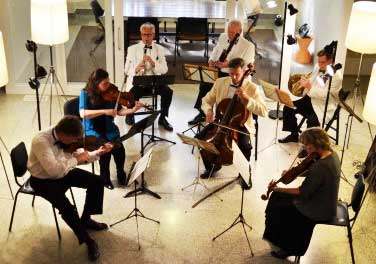We recently played a program called “Blessed Spirits” named as a result of the first piece by Christoph Willibald Gluck entitled the “Dance of the Blessed Spirits” from his opera Orfeo.
 It featured our flutist, Jean Berkenstock, in one of the most sublime and hauntingly beautiful instrumental solos in the entire operatic literature. We performed this program in five different locations, but it was the concert that we did in the Arketype Atrium in Green Bay on Father’s Day, that got me thinking. It was a benefit for the East High School Fine Arts Institute, whose purpose is to support the arts at East High and to especially help the youth at East gain an understanding of the importance of art and music in their lives.
It featured our flutist, Jean Berkenstock, in one of the most sublime and hauntingly beautiful instrumental solos in the entire operatic literature. We performed this program in five different locations, but it was the concert that we did in the Arketype Atrium in Green Bay on Father’s Day, that got me thinking. It was a benefit for the East High School Fine Arts Institute, whose purpose is to support the arts at East High and to especially help the youth at East gain an understanding of the importance of art and music in their lives.
While Gluck’s operatic masterpiece suggested the title, it also suggested a broader underlying subtext. How do musicians of today bring a piece of music to life and fathom the intentions of a particular blessed soul (composer) who committed some notation to paper perhaps 200 years ago or more? Our involvement with the East High program made me think of the daunting task one has in teaching music to youngsters. It is one thing to teach someone how to play this pitch or that on an instrument and how to reproduce accurately different rhythmic patterns. It is quite another for a student to figure out the spirit of what a composer wanted that notation to convey.
If you examine a piece of music, it is made up of five-line staves with a bunch of black blobs and open circles with little stems on them. That suggests something about the basic framework of a piece of music, but where does one look for the real music on those pages? “Inside,” is the answer. One has to look between the notes and then delve into one’s own interior.
Fortunately, as listeners trying to comprehend what we are hearing, and as performers trying to interpret a piece of music in a way that is compelling to the listeners, we have something very helpful to fall back upon – our Mother Tongue! The biggest reason we are able to comprehend the music between the notes, as listeners or performers, is our ability to learn and comprehend language.
I don’t think we fully appreciate how musical our language really is. Every language is full of music, and we start learning it from just after birth as readily as we learn to walk – no private lessons required. In Chinese, there are four different “tones” for each word. Put the wrong tone on a word and you have said something entirely different from what you intended. If you speak Chinese and don’t want to be embarrassed, you had better learn to sing!
Try this little test. Say the phrase, “I can’t believe she is really interested in that guy.” Repeat the same phrase several times, and each time place the emphasis on a different word (your pitch will follow suit). Notice how the meaning changes depending on whether you emphasize “believe,” “she,” “really,” etc.. Each has a nuanced difference in meaning. If you are reading that phrase in a novel, you have to decide what the author really intends. Musician do the same.
How did we learn these subtle shadings of meaning? Remember your mother talking baby talk to you? (If you do, your memory is a lot better than mine). Studies show that those overdone “goo-goos” help the infant start to focus on pitch in a way that prepares for language understanding. Remember that we don’t start learning the alphabet at six months in order to learn to speak. We just start singing the words and connecting them in meaningful ways. This is the thought behind the Suzuki program that teaches the shape of music before it teaches musical notation. It follows the same path that our brain is already wired for in understanding language.
There is so much more I could go into on this subject, but for now, let me just suggest that you come hear our Midsummer’s Music concerts on Friday, June 28 at The Hardy Gallery in Ephraim, Saturday, June 29 at Sister Bay Moravian Church, or Sunday, June 30 at Woodwalk Gallery in Egg Harbor. We’ll be speaking your language, and it will be perfectly clear because of all those goo-goos from way back when.
Please, call 920.854.7088 or click to make reservations 0nline.
